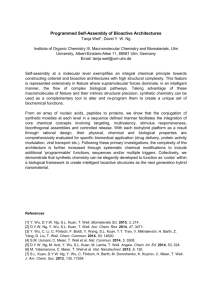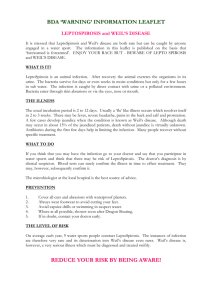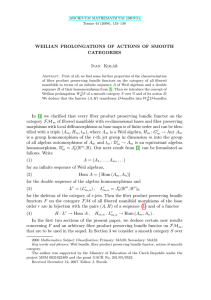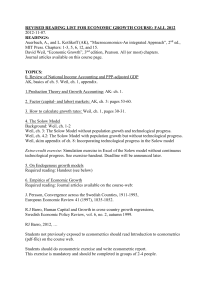ON THE GEOMETRY OF VERTICAL WEIL BUNDLES Ivan Kolář
advertisement
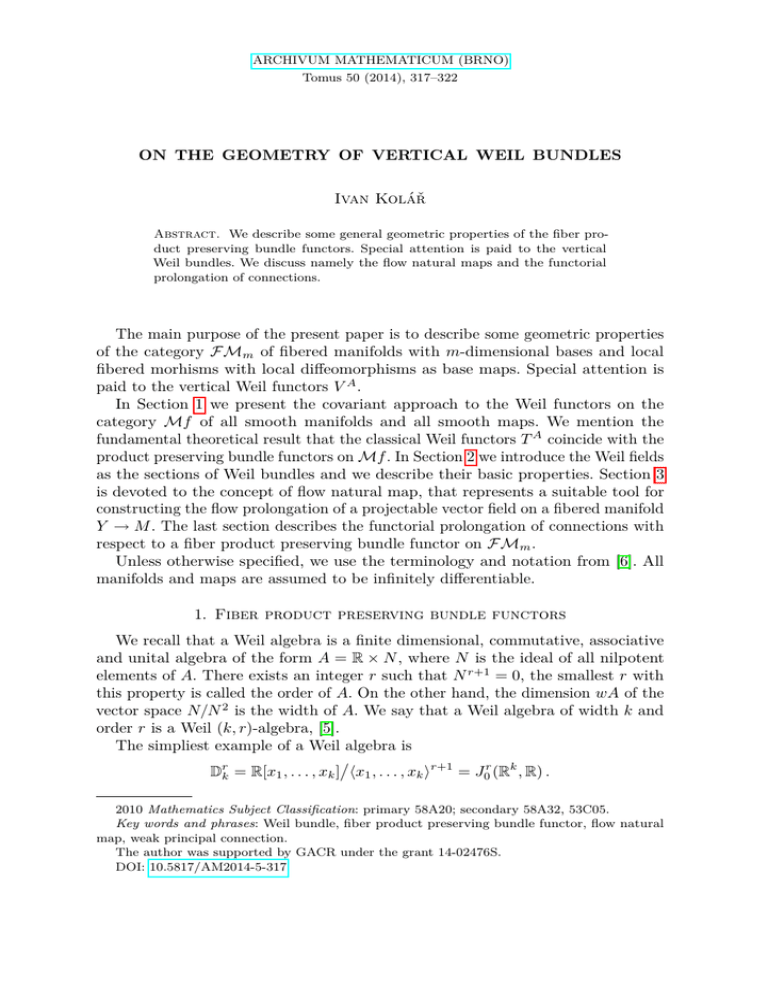
ARCHIVUM MATHEMATICUM (BRNO)
Tomus 50 (2014), 317–322
ON THE GEOMETRY OF VERTICAL WEIL BUNDLES
Ivan Kolář
Abstract. We describe some general geometric properties of the fiber product preserving bundle functors. Special attention is paid to the vertical
Weil bundles. We discuss namely the flow natural maps and the functorial
prolongation of connections.
The main purpose of the present paper is to describe some geometric properties
of the category FMm of fibered manifolds with m-dimensional bases and local
fibered morhisms with local diffeomorphisms as base maps. Special attention is
paid to the vertical Weil functors V A .
In Section 1 we present the covariant approach to the Weil functors on the
category Mf of all smooth manifolds and all smooth maps. We mention the
fundamental theoretical result that the classical Weil functors T A coincide with the
product preserving bundle functors on Mf . In Section 2 we introduce the Weil fields
as the sections of Weil bundles and we describe their basic properties. Section 3
is devoted to the concept of flow natural map, that represents a suitable tool for
constructing the flow prolongation of a projectable vector field on a fibered manifold
Y → M . The last section describes the functorial prolongation of connections with
respect to a fiber product preserving bundle functor on FMm .
Unless otherwise specified, we use the terminology and notation from [6]. All
manifolds and maps are assumed to be infinitely differentiable.
1. Fiber product preserving bundle functors
We recall that a Weil algebra is a finite dimensional, commutative, associative
and unital algebra of the form A = R × N , where N is the ideal of all nilpotent
elements of A. There exists an integer r such that N r+1 = 0, the smallest r with
this property is called the order of A. On the other hand, the dimension wA of the
vector space N/N 2 is the width of A. We say that a Weil algebra of width k and
order r is a Weil (k, r)-algebra, [5].
The simpliest example of a Weil algebra is
Drk = R[x1 , . . . , xk ] hx1 , . . . , xk ir+1 = J0r (Rk , R) .
2010 Mathematics Subject Classification: primary 58A20; secondary 58A32, 53C05.
Key words and phrases: Weil bundle, fiber product preserving bundle functor, flow natural
map, weak principal connection.
The author was supported by GACR under the grant 14-02476S.
DOI: 10.5817/AM2014-5-317
318
I. KOLÁŘ
In particular, D11 = : D is the algebra of Study numbers. In [5], we deduced
Lemma 1. Every Weil (k, r)-algebra is a factor algebra of Drk . If %, σ : Drk → A
are two algebra epimorphisms, then there is an algebra isomorphism χ : Drk → Drk
such that % = σ ◦ χ.
Definition 1. Two maps γ, δ : Rk → M determine the same A-velocity j A γ = j A δ,
if for every smooth function ϕ : M → R
(1)
% j0r (ϕ ◦ γ) = % j0r (ϕ ◦ δ) .
By Lemma 1 this is independent of the choice of %. One verifies easily, [6], that
the bundle of all A-velocities
T A M = {j A γ, γ : Rk → M }
(2)
coincides with the bundle of infinitely near points of type A on M introduced by
A. Weil, [9]. For every smooth map f : M → N , we define T A f : T A M → T A N by
T A f (j A γ) = j A (f ◦ γ) .
(3)
Clearly, T A R = A.
We say that (2) and (3) represents the covariant approach to Weil bundles. The
following result is a fundamental assertion, see [6] for a survey.
Theorem 1. The product preserving bundle functors on Mf are in bijection with
T A . The natural transformations T A1 → T A2 are in bijection with the algebra
homomorphisms µ : A1 → A2 .
We write µM : T A1 M → T A2 M for the value of µ : A1 → A2 on M . If A is a
Weil (ki , ri )-algebra, i = 1, 2, then there exists a polynomial map µ̄ : Rk2 → Rk1
such that
µM (j A1 γ) = j A2 (γ ◦ µ̄) ,
(4)
γ : Rk1 → M .
The iteration T A2 T A1 corresponds to the tensor product of A1 and A2 . The
algebra exchange homomorphism ex : A1 ⊗A2 → A2 ⊗A1 defines a natural exchange
A1 ,A2
transformation iM
: T A1 T A2 M → T A2 T A1 M . We have T = T D .
A
The canonical exchange κM
: T A T M → T T A M is called flow natural. Indeed,
X
if F lt is the flow of a vector field X : M → T M , then the flow prolongation of X
is defined by
∂ (5)
T A X = T A (F ltX ) : T A M → T T A M .
∂t 0
One deduces easily, [6],
A
T A X = κM
◦ T AX .
(6)
Further, consider a bundle functor F on FMm that preserves fiber products.
Examples are the r-th jet prolongation J r Y of a fibered
S A manifold p : Y → M ,
dim M = m, the vertical A-prolongation V A Y =
T (Yx ), the vertical r-jet
x∈M
S r
prolongation
Jx (M, Yx ) and iterations.
x∈M
ON THE GEOMETRY OF VERTICAL WEIL BUNDLES
319
We say F is of the base order r, if for two FMm -morphisms ϕ, ψ : Y → Y 0
of p : Y → M into p0 : Y 0 → M 0 with base maps ϕ, ψ : M → M 0 , jxr ϕ = jxr ψ and
ϕ | Yx = ψ | Yx imply F ϕ | Fx Y = F ψ | Fx Y , x ∈ M .
Let Mfm be the category of m-dimensional manifolds and their local diffeomorphisms. The construction of product fibered manifolds defines an injection ι : Mfm × Mf → FMm , ι(M, N ) = (M × N → M ), ι(f1 , f2 ) = f1 × f2 ,
f1 : M → M 0 , f2 : N → N 0 .
W. Mikulski and the author deduced, [7], that the bundle functors Φ = F ◦ ι
on Mfm × Mf are in bijection with the pairs (A, H), where A is a Weil algebra and H : Grm → Aut A is a group homomorphism of the r-jet group in
dimension m into the group of all automorphisms of A. Since H(g) : A → A
is an algebra automorphism for every g ∈ Grm , we have the induced action
HN (g) = H(g)N : T A N → T A N of Grm on T A N . Then Φ(M, N ) is the associated fiber bundle P r M [T A N ]. For a local diffeomorphism f1 : M → M 0 and a
smooth map f2 : N → N 0 ,
(7)
Φ(f1 , f2 ) = P r f1 [T A f2 ] : Φ(M, N ) → Φ(M 0 , N 0 ) ,
where P r f1 : P r M → P r M 0 is the induced local isomorphisms of principal bundles
and T A f2 : T A N → T A N 0 is a Grm -equivariant map, [5].
Then the functor F is determined by adding an equivariant algebra homomorphism t : Drm → A, where Aut Drm = Grm . We have
(8) F Y = {u, Z} ∈ P r M [T A Y ], tM (u) = T A p(Z), u ∈ Pxr M, Z ∈ T A Y ,
r
r
where tM : Tm
M → T A M and P r M ⊂ Tm
M . For an FMm -morphism f : Y → Y 0
0
over f : M → M , F f is the restriction of Φ(f , f ) to F Y . In the product case
Y = M × N , we have
(9)
F (M × N ) = P r M [T A N ] .
If we consider another fibered manifold Y 0 → M over M and f = id M , we have
(10)
F f {u, Z} = u, T A f (Z) .
Further, t induces a natural map
(11)
r
e
tY : J r Y → F Y, {u, Z} 7→ u, tY (Z) , u ∈ P r M, Z ∈ Tm
Y.
f → Y , where
Geometrically, we interpret a section s : M → Y as a morphism se: M
id
f = (M → M ) is the “doubled” manifold. Then F se is identified with j r s and
M
e
tY (jxr s) = (F se)(x).
Remark 1. We remark that W. Mikulski has recently described another construction of F = (A, H, t), [8].
2. Prolongation of Weil fields
Write πA,M : T A M → M for the bundle projection.
Definition 2 ([1]). A section ξ : M → T A M is called an A-field on M .
320
I. KOLÁŘ
Consider another Weil algebra B. Let X ∈ T B (T A M ), X = j B ϕ, where ϕ : Rl →
T A M , l = the width of B. Every ϕ(t) ∈ T A M , t ∈ Rl is of the form j A ψ(τ, t),
τ ∈ Rk , where ψ is a map Rk × Rl → M . Hence X = j B (j A ψ(τ, t)) and the
B
A
A
B
exchange diffeomorphism iB,A
M : T (T M ) → T (T M ) is of the form
A B
(12)
iB,A
j ψ(τ, t) .
M (X) = j
Consider the bundle projection πB,T A M : T B T A M → T A M and the induced map
T B πA,M : T B T A M → T B M . One verifies easily that iB,A
exchanges the related
M
projections, i.e.
(13)
T A πB,M ◦ iB,A
M = πB,T A M ,
B
πA,T B M ◦ iB,A
M = T πA,M .
B
B
Definition 3. Let ξ : M → T A M be an A-field on M . The A-field iB,A
M ◦T ξ : T M →
T A (T B M ) on T B M will be called the B-prolongation of ξ.
The flow prolongation of a projectable vector field η on a fibered manifold
p : Y → M with respect to F is defined by a formula analogous to (5)
∂ (14)
Fη = F F ltη : F Y → T F Y .
∂t 0
Now we discuss the special case of the vertical Weil bundle V A Y → M of a fibered
manifold p : Y → M . Consider the subbundles V B (T A Y → T A M ) ⊂ T B T A Y and
T A (V B Y ) ⊂ T A T B Y .
Lemma 2. iB,A
maps V B (T A Y → T A M ) into T A (V B Y ).
Y
Proof. By locality, it suffices to consider a product bundle Y = (M × N ) → M .
We have
T A Y = T A M × T A N , V B (T A Y → T A M ) = T A M × T B T A N ,
V B Y = M × T B N , T A (V B Y ) = T A M × T A T B N .
In this situation, iB,A
is reduced to the exchange diffeomorphism
Y
B A
A B
iB,A
:
T
T
N
→
T
T
N.
N
The restricted and corestricted map, that will be denoted by
(15)
B
A
A
B
iB,A
Y,V : V (V Y → M ) → V (V Y → M ) ,
represents the exchange diffeomorphism applied fiberwise. For B = D, we write
(16)
A
κY,V
: V (V A Y → M ) → V A (V Y → M ) .
Let η be a vertical vector field on Y and V A η be its flow prolongation. Analogously
to (6), we obtain
(17)
A
V A η = κY,V
◦ V Aη .
Remark 2. It is remarkable that we also have a canonical exchange
(18)
J r (V A Y → M ) → V A (J r Y → M ) , jxr j A ϕ(τ, t) 7→ j A jxr ϕ(τ, t) ,
ON THE GEOMETRY OF VERTICAL WEIL BUNDLES
321
τ ∈ M , t ∈ Rl , [5]. Indeed, locally is Y isomorphic to U × N , U ⊂ Rm . In
Dr ,A
such a situation, (18) is reduced to the canonical exchange transformation iNk
corresponding to (12).
3. The flow natural map
In the case of a fiber product preserving bundle functor F = (A, H, t) on FMm ,
we have the following analogy of the flow natural map from Section 1. Consider a
vector field ξ on M . Its flow prolongation P r ξ is a right invariant vector field on
the r-th order frame bundle P r M , whose value at every u ∈ Pxr M depends on jxr ξ
only. This defines a map
(19)
r
νM
: P r M ×M J r T M → T P r M .
For a fibered manifold p : Y → M , we will consider T Y as a fibered manifold T Y → M . Then T p : T Y → T M is a base preserving morphism, that
induces F T p : F T Y → F T M . Taking into account the natural transformation
e
tT M : J r T M → F T M , we construct the fiber product
(20)
J r T M ×F T M F T Y .
By (8), we have F T Y ⊂ P r M [T A T Y ]. Consider (X, {u, Z}) in (20), X ∈ Jxr T M ,
r
u ∈ Pxr M , Z = T A T Y . Write νM
(u, X) = (∂/∂t)0 γ(t), γ : R → P r M . By Section 1,
A
A
κY (Z) ∈ T T Y can be expressed as (∂/∂t)0 ξ(t), where ξ : R → T A Y satisfies
tY (γ(t)) = T A p(ξ(t)) for all t. So {γ(t), ξ(t)} is a curve on F Y and we define
∂ (21)
ψYF X, {u, Z} = γ(t), ξ(t) .
∂t 0
By right invariancy, this is independent of the choice of u. Hence we obtain a map
(22)
ψYF : J r T M ×F T M F T Y → T F Y .
A projectable vector field η on Y over ξ on M can be interpreted as a base
preserving morphism η : Y → T Y . Then we construct its functorial prolongation
F η : F Y → F T Y as well as the r-th jet prolongation j r ξ : M → J r T M . The values
of j r ξ ×id M F η with respect to ψYF are in T F Y . The proof of the following assertion
can be found in [4].
Proposition 1. The flow prolongation Fη satisfies
(23)
Fη = ψYF (j r ξ ×id M F η) .
In the case of F = V A , the base order of V A is zero, so that (23) is defined on
the space
(24)
T M ×V A T M V A T Y ≈ V A T Y .
For a vertical field η on Y , we have ξ = OM . By (23), we rededuce
A
V A η = κY,V
◦ V Aη .
322
I. KOLÁŘ
4. Functorial prolongation of connections
It was clarified in several concrete problems that if F is of base order r, we
need an auxiliarly linear splitting Λ : T M → J r T M to construct an induced
connection F(Γ, Λ) : F Y ×M T M → T F Y from a general connection on Y , which
is considered as a lifting map Γ : Y ×M T M → T Y linear in T M , [6], [3]. Consider
a vector field ξ : M → T M and its Γ-lift Γξ : Y → T Y . The flow prolongation
F(Γξ) : F Y → T F Y depends on j r ξ only. This defines FΓ : J r T M ×M F Y → T F Y
linear in J r T M . Then F(Γ, Λ) = FΓ ◦ (Λ ×id M id F Y ).
It is useful to describe this construction by using the flow natural map ψYF . In
Section 1, we constructed e
tT M : J r T M → F T M . Consider a projectable vector
field η : Y → T Y over ξ : M → T M . If we interpret η as an FMm -morphism
η : Y → T Y over id M , we can construct F η : F Y → F T Y . By (23), we have
Fη = ψYF (j r ξ ×id M F η) for every η. This map is linear in J r T M . Hence
(25)
F(Γ, Λ) = ψYF Λ(X), v = FΓ ◦ (Λ ×id M id F Y ) ,
X ∈ Tx M , v ∈ Fx Y .
References
[1] A. Cabras, I. Kolář, Prolongation of second order connections to vertical Weil bundles, Arch.
Math. (Brno) 37 (2001), 333–347.
[2] A. Cabras, I. Kolář, On the functorial prolongations of principal bundles, Comment. Math.
Univ. Carol. 47 (2006), 719–731.
[3] A. Čap, J. Slovák, Parabolic Geometries I, Mathematical Surveys and Monographs, Vol. 154,
AMS, Providence, USA, 2009.
[4] I. Kolář, On the geometry of fiber product preserving bundle functors, Differential Geometry
and its Applications, Proceedings, Silesian University of Opava (2002), 63–72.
[5] I. Kolář, Weil Bundles as Generalized Jet Spaces, in: Handbook of Global Analysis, Elsevier,
Amsterdam (2008), 625–664.
[6] I. Kolář, P. W. Michor, J. Slovák, Natural Operations in Differential Geometry, Springer
Verlag, 1993.
[7] I. Kolář, W. M. Mikulski, On the fiber product preserving bundle functors, Differential Geom.
Appl. 11 (1999), 105–115.
[8] W. M. Mikulski, Fiber product preserving bundle functors as modified vertical Weil functors,
11 pp., to appear in Czechoslovak Math. J.
[9] A. Weil, Théorie des points proches sur les variétes différentielles, Colloque de topol. et
géom. diff., Strasbourg (1953), 111–117.
Institute of Mathematics and Statistics, Masaryk University,
Kotlářská 2, CZ 611 37 Brno, Czech Republic
E-mail: kolar@math.muni.cz
